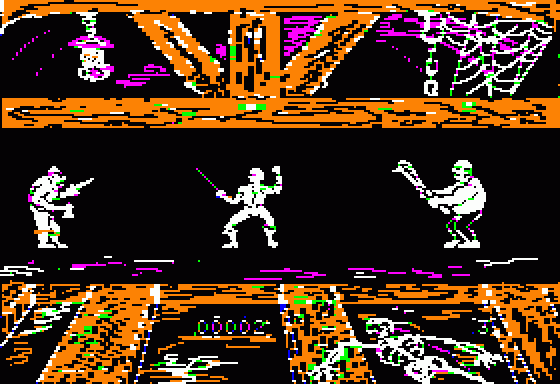Retro Replay Review
Gameplay
Swashbuckler delivers a straightforward yet addictive combat loop that captures the essence of early arcade-style fighting. From the moment you take center stage, enemies pour in from both the left and right sides of the screen—humans brandishing weapons, slithering snakes, and scurrying rats. Each foe demands constant attention, pushing you to anticipate patterns and react with split-second decisions.
(HEY YOU!! We hope you enjoy! We try not to run ads. So basically, this is a very expensive hobby running this site. Please consider joining us for updates, forums, and more. Network w/ us to make some cash or friends while retro gaming, and you can win some free retro games for posting. Okay, carry on 👍)
Your arsenal is simple but effective: a sword that can strike high, low, or center, plus a block option to parry incoming attacks. Mastering the timing and rhythm of these three strike zones is key. A well-timed high cut can dispatch a charging swordsman, while a low slash neatly dispatches a rat weaving beneath your guard. Blocking becomes essential as enemy density increases, but holding your guard leaves you vulnerable to feints and faster opponents.
As rounds progress, the speed and number of adversaries ramp up quickly, testing your reflexes and endurance. What starts as manageable waves soon devolves into a flurry of pixelated blades and chittering vermin. The rapid escalation in difficulty means that a single lapse in concentration can quickly end your run. For players who relish high-score chases and twitch-based challenges, Swashbuckler’s relentless pace offers a raw, pulse-pounding experience.
Graphics
Visually, Swashbuckler embraces the limitations of early home computers with modest yet charming sprite work. Characters are rendered in simple block colors, but the animations—albeit brief—convey enough motion to give each enemy type a unique personality. The snakes coil and uncoil menacingly, while rats scamper with frantic urgency around your feet.
The single-screen setup means most of your visual interest comes from the action zone itself. Backgrounds remain static, allowing the boldly colored sprites to stand out against a plain backdrop. This minimalist approach might feel sparse by modern standards, yet it keeps the focus squarely on combat. Occasionally, brief flash effects punctuate successful strikes or blocks, adding a touch of visual feedback that heightens the sense of impact.
Color palettes are limited to a handful of hues, but that paucity lends Swashbuckler a retro charm. Each enemy type is instantly recognizable by its tint and shape, which is crucial when multiple foes converge at once. While you won’t find lush environments or cinematic cut-scenes, the game’s graphical style feels cohesive, functional, and true to its arcade origins.
Story
Swashbuckler doesn’t offer a deep narrative or sprawling lore; instead, it relies on the timeless appeal of a lone swordsman fending off waves of adversaries. You are the titular swashbuckler—an anonymous hero whose only objective is to stay alive as long as possible. This no-frills premise fits the game’s pick-up-and-play spirit, where the challenge resides in reflexes rather than plot twists.
Occasional title screens or brief intermissions might hint at a pirate or dungeon theme, but there’s no inventory system, dialogue, or unfolding saga. That said, fans of classic arcade fighters will appreciate how the game evokes a gladiatorial atmosphere—each wave of enemies a new test of skill, each defeat a prompt to jump back in and push your high score further.
Any narrative you imbue is born from your own triumphs and failures. Clearing ten waves without taking a hit feels like an epic duel worthy of legend, even if the game itself never labels it as such. In the context of early 1980s titles, this barebones storytelling is par for the course, leaving room for players to imagine themselves as the master swordsman at the heart of this relentless trial.
Overall Experience
Playing Swashbuckler today is like stepping into a virtual arcade from decades past. The immediate appeal lies in its pure, uncompromising challenge. There’s no leveling, no power-ups, just you, your sword, and an endless tide of enemies. For those seeking depth or variety, this might feel repetitive after prolonged sessions. Yet for aficionados of high-score duels and quick reflex tests, the game remains a rewarding exercise in precision and perseverance.
Swashbuckler’s simplicity is both its strength and its limitation. It won’t dazzle modern gamers expecting rich narratives or expansive worlds, but it delivers exactly what it sets out to: an escalating gauntlet of combat scenarios that demand split-second decisions. Its endurance-based difficulty curve can be brutally steep, so players should be prepared for short, intense runs rather than marathon campaigns.
If you’re a collector of retro titles or a fan of twitch-focused challenges, Swashbuckler offers a window into the early days of home computer gaming. It’s less about variety and more about refining a core mechanic to perfection. For those willing to embrace its pixelated austerity, the thrill of mastering each wave and carving out a new high score makes this unassuming title a memorable relic of a bygone era.
 Retro Replay Retro Replay gaming reviews, news, emulation, geek stuff and more!
Retro Replay Retro Replay gaming reviews, news, emulation, geek stuff and more!









Reviews
There are no reviews yet.